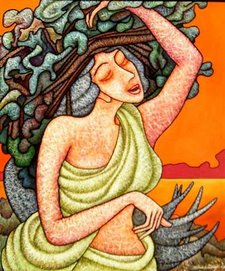The one thing that we were very keen on doing was watching a flamenco performance. Coming to Spain and not watching the flamenco is like commiting blasphemy...Surfing the net, asking the concierge, reading local recommnedations, we zeroed in on 3 possibilities:
Café de ChinitasCalle Torija, 7, Madrid, Spain 28013 · 91-559-51-35
Corral de la MoreríaCalle de Morería, 17, Madrid, Spain 28005 · 91-365-8446
Over the years some of the most famous performers from the flamenco world have performed here including Pastora Imperio, La Chunga, María Albaicín, Fosforito, Serranito, El Güito, Lucero Tena, Isabel Pantoja and Blanca Del Rey. The place has attracted visitors from all over the world including such celebrities as Frank Sinatra, Pablo Picasso, Salvador Dalí, Muhammed Ali and U2, to name just a few.Casa PatasCalle de Cañizares, 10, Madrid, Spain · 91-369-04-96
Casa Patas offers some of the finest flamenco performances in Madrid with artists of the stature of Chaquetón, Remedios Amaya, Chano Lobato, La Niña Pastori and many more. Its famous guests include Johnny Depp, Naomi Campbell, Antonio Canales and William Dafoe.After going through all of these, we decided on Casa Patas. As our concierge told us, this club is now one of the best places to see "true" flamenco as opposed to the more tourist-oriented version presented at Corral de la Morería .

Listening to them sing, the Moorish / Islamic influence on the Spannish music is rather obvious...however, the difference being that Arabic music tends to be uni- beat while the flamenco music has huge variations in pitch, tone and beat...and you need to have a strong, powerful voice with a good throw...
It is also a bar and restaurant, with space reserved in the rear for flamenco. Shows are presented midnight on Thursday, Friday, and Saturday and during Madrid's major fiesta month of May. Additionally, flamenco singers and dancers often hang out here after hours, and, mix around and chat with the guests if you want to spend some time. Tickets are priced at Euro 30 per head for an adult and Euro 13 for a child less than 12 years old. This price includes one free drink on the house.
You can also order tapas while watching the performance. As a general rule, food at flamenco clubs is not phenomenal but hubby ordered some tapas which he said were quite nice. Of course, there was nothing vegetarian available, not even the ubiquitous spannish omlette! Plus food at flamenco shows is almost always expensive. Two plates of tapas were almost the same price of all 3 tickets! So, if you're on a budget, its a good idea to go have a meal outside, and then go for a late night performnace and enjoy your drinks at the tablaos. And in case you are a vegetarian, its anyways a good idea! lol!

What we saw was a wonderful Flamenco Tablaos, and, I was so glad that we chose Casa Patas! The club has an intimate, personal feel to it and the singers and the dancers (one male & one female) were excellent! Two guys played the guitar effortlessly while the two singers had very powerful yet melodious voices....
Hearing the singers sing, I thought the music had many similarities to Arabic music which may well be explained by the Islamic influence in Spain. However, unlike Arabic music, there are a lot of changes in tempo and rythm in this music, which is what makes it fascinating. The male and the female dancers were brilliant, matching their steps to the rising crescendo of the songs. We were so caught up in the performace, that did not realise when the show ended and it was time to go home!
 As for restaurants, there is a wide variety, though essentially continental to choose from..There is an English style pub, a karaoke bar, and, hold your breath, a salsa bar playing foot tapping music and people were dancing and drinking the night away...
As for restaurants, there is a wide variety, though essentially continental to choose from..There is an English style pub, a karaoke bar, and, hold your breath, a salsa bar playing foot tapping music and people were dancing and drinking the night away...






















